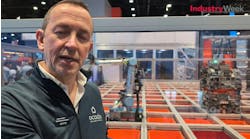"Many people miss the real value of simulation because they don't take it far enough," says Randall Gibson, president of Automation Associates, Inc. (Solana Beach, Calif.). They fail to explore the implications of operational changes and how the addition of new equipment, systems and software will impact the productivity of a warehouse.
The first step is to determine if simulation is the correct tool to use. Many experts agree simulation should be used when new processes are introduced; if it is a high-volume or complex picking environment that requires components to come together at the consolidation area at the right time; when new rules from a WMS system are being implemented; and in a high-volume facility where there are deadlines. Simulation is not the right tool for every warehouse design or redesign project.
"You need to define what the problem is and decide if simulation is the solution to help solve the problem," says Donald E. Kuzma, president, Trommer & Associates Inc. (Akron). It is not the right tool, he says, for facilities with straightforward processes; low volume; no timing issues; no new equipment being introduced or equipment being used differently; or when the warehouse's processes are not being changed.
Here are the top five reasons for using simulation software:
1. Proof of Concept
Simulation is well suited for showing how an automated material handling system will operate and for determining throughput and rates. In a project for Pioneer Standard Electronics (now Agilysys, Inc., Mayfield Heights, Ohio) Kuzma's team used simulation to show how new packing benches would work with an inserter/extractor carrousel. "This was a new concept for Pioneer. There was not an example nearby that they could go and see, so simulation was used to demonstrate how it would work," he explains.
Once a model is made, it is easy to play 'what if' games. Different variables, like labor inputs, can be added to the model. Changing this variable showed Pioneer the optimal number of employees it would need on different carrousels to increase the number of orders it processed each day from 1,200 to 2,000.
Simulations find flaws in designs that may only appear when the system is used. In Pioneer's case, a week's worth of data was run though a model of a random putaway system before the flaw appeared. The system was pulling from 32 different carrousels which resulting in too many totes being put on the system. They changed to a different random putaway system that reduced the load on the conveyor system.
2. Executive and Employee Buy-In
It is much easier to sell an idea or concept when it can be visualized. " Simulation was a good way to show management how adding a conveyor system and software would improve the business," explains Pat Rosenthal, former Central Distribution Center Manager at Pioneer. He showed the project's simulations to doubtful employees. "We actually had a simulation of someone standing at a workstation demonstrating what the job would be and where the cart would be located. Once they saw this simulation, they realized they had a part to play in the new facility," he says.
A lot of data is collected to create simulations. This data is very useful when selling a concept to executives. But, Rosenthal says, the right data needs to be collected and presented, because the success of the project depends on those figures. Executives will want to know about line counts, capacities, throughputs, rates, and dollar values. A simulation can provide these.
3. Optimize Operational and Business Rules
Just simulating the equipment and the material flow rates has nothing to do with companies' real business requirements. Simulation can be taken to the next level by overlaying operational procedures and business rules over equipment simulations. This type of simulation shows companies how and if warehouse designs are in line with their business requirements. Running tests with the model show what the rules will actually do. Because this type of simulation requires more expertise, time and involvement, many companies will not take the time to create the model, says Automation Associates' Gibson.
4. Optimize the Control System
"The value of simulation modeling comes when companies model the business rules that are built into the warehouse management system that controls their processes," Gibson says. Sometimes the flaws that simulation reveals are actually in the control systems or operational procedures. This part of the design process is generally not considered as carefully as the layout is before startup. Gibson has clients think about and define their operational rules and control processes before creating a model that incorporates those rules. The result is more useful and realistic and can be used to simulate the impact of their WMS system.
For example, he explains, a WMS makes decisions about grouping and releasing items. These decisions can be reduced to a relatively simple set of control system rules that can be implemented in a model that can show what the rules will do to the operational throughput and productivity.
Companies implementing ERP systems are concerned about how it will impact their WMS. The impact can be simulated, Gibson says. "People don't realize you can do that." It all depends on the operational rules that the WMS will implement. "It's really straightforward to simulate and has potentially huge impact in terms of the way the system operates."
5. Revalidate the Design
A warehouse simulation is often used once and thrown away. They are much more valuable if they are resurrected and used by managers on an occasional basis. After all, facilities and businesses change. Changes that occur after a simulation can cause bottlenecks and reduce productivity and capacity. "Managers don't think to go back often and reanalyze what the impact of change might be," Gibson says. He adds that some customers today are asking to have a simulation-based tool delivered to them with a friendly user interface that would let them make updates to double check if adding new equipment will have an impact.
A simulation of an inserter/extractor can show executives and employees how the unit operates and the rates at which it runs.


